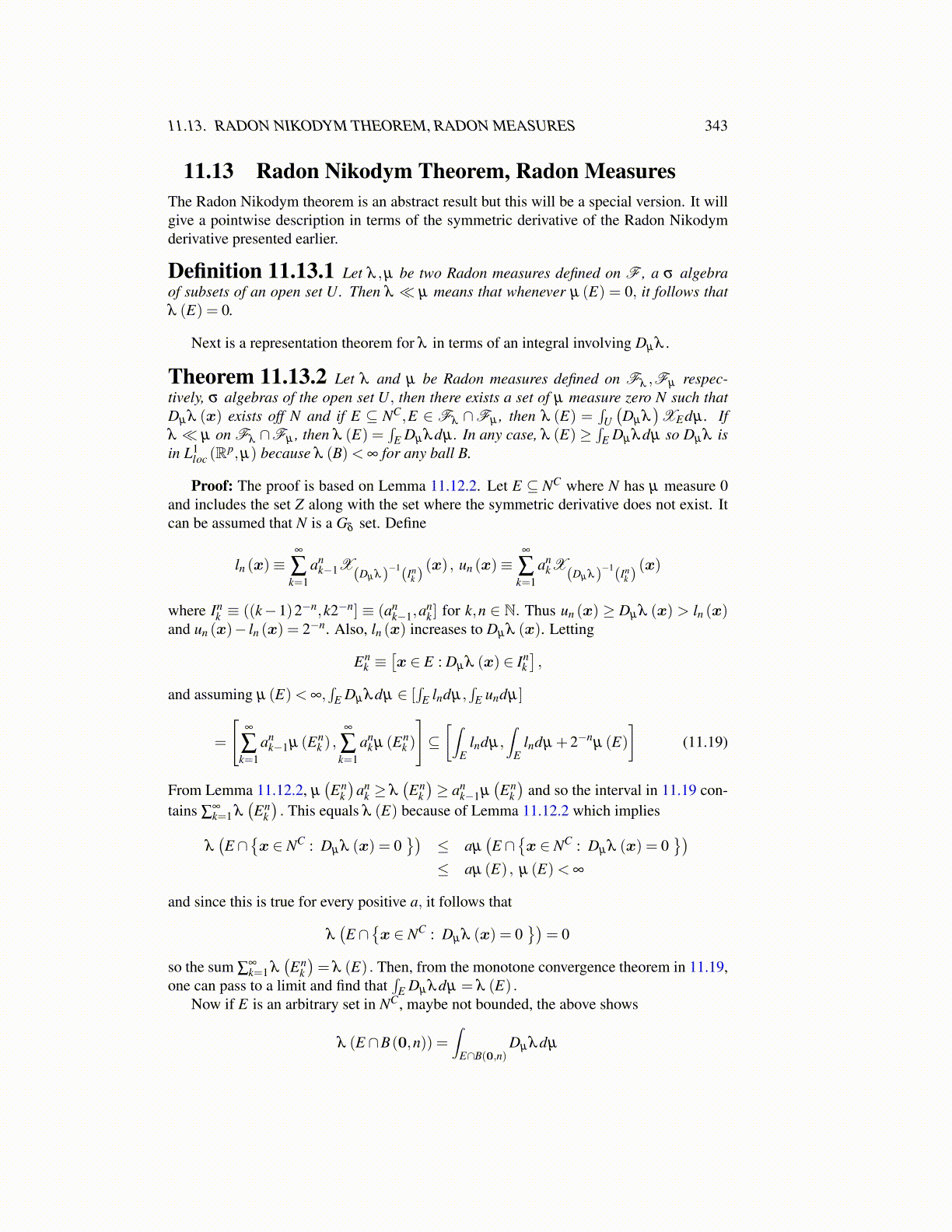
11.13. RADON NIKODYM THEOREM, RADON MEASURES 343
11.13 Radon Nikodym Theorem, Radon MeasuresThe Radon Nikodym theorem is an abstract result but this will be a special version. It willgive a pointwise description in terms of the symmetric derivative of the Radon Nikodymderivative presented earlier.
Definition 11.13.1 Let λ ,µ be two Radon measures defined on F , a σ algebraof subsets of an open set U. Then λ ≪ µ means that whenever µ (E) = 0, it follows thatλ (E) = 0.
Next is a representation theorem for λ in terms of an integral involving Dµ λ .
Theorem 11.13.2 Let λ and µ be Radon measures defined on Fλ ,Fµ respec-tively, σ algebras of the open set U, then there exists a set of µ measure zero N such thatDµ λ (x) exists off N and if E ⊆ NC,E ∈ Fλ ∩Fµ , then λ (E) =
∫U(Dµ λ
)XEdµ . If
λ ≪ µ on Fλ ∩Fµ , then λ (E) =∫
E Dµ λdµ . In any case, λ (E)≥∫
E Dµ λdµ so Dµ λ isin L1
loc (Rp,µ) because λ (B)< ∞ for any ball B.
Proof: The proof is based on Lemma 11.12.2. Let E ⊆ NC where N has µ measure 0and includes the set Z along with the set where the symmetric derivative does not exist. Itcan be assumed that N is a Gδ set. Define
ln (x)≡∞
∑k=1
ank−1X(Dµ λ)
−1(In
k )(x) , un (x)≡
∞
∑k=1
ankX(Dµ λ)
−1(In
k )(x)
where Ink ≡ ((k−1)2−n,k2−n] ≡ (an
k−1,ank ] for k,n ∈ N. Thus un (x) ≥ Dµ λ (x) > ln (x)
and un (x)− ln (x) = 2−n. Also, ln (x) increases to Dµ λ (x). Letting
Enk ≡
[x ∈ E : Dµ λ (x) ∈ In
k],
and assuming µ (E)< ∞,∫
E Dµ λdµ ∈ [∫
E lndµ,∫
E undµ]
=
[∞
∑k=1
ank−1µ (En
k ) ,∞
∑k=1
ank µ (En
k )
]⊆[∫
Elndµ,
∫E
lndµ +2−nµ (E)
](11.19)
From Lemma 11.12.2, µ(En
k
)an
k ≥ λ(En
k
)≥ an
k−1µ(En
k
)and so the interval in 11.19 con-
tains ∑∞k=1 λ
(En
k
). This equals λ (E) because of Lemma 11.12.2 which implies
λ(E ∩
{x ∈ NC : Dµ λ (x) = 0
})≤ aµ
(E ∩
{x ∈ NC : Dµ λ (x) = 0
})≤ aµ (E) , µ (E)< ∞
and since this is true for every positive a, it follows that
λ(E ∩
{x ∈ NC : Dµ λ (x) = 0
})= 0
so the sum ∑∞k=1 λ
(En
k
)= λ (E) . Then, from the monotone convergence theorem in 11.19,
one can pass to a limit and find that∫
E Dµ λdµ = λ (E) .Now if E is an arbitrary set in NC, maybe not bounded, the above shows
λ (E ∩B(0,n)) =∫
E∩B(0,n)Dµ λdµ